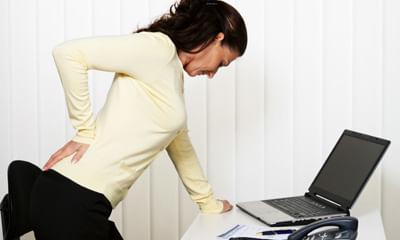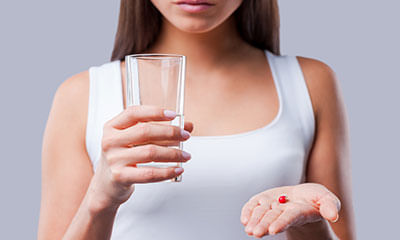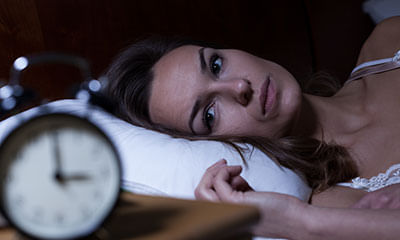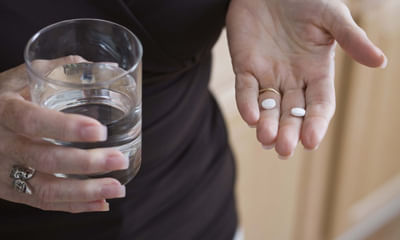Medicine For Postmenopausal Symptoms
Hi, my mother, 52, is post-menopausal, obese (91. 1 kgs), recently hypertension (bp 120/80 with meds) has a case history ...
Ask Free Question
Dear lybrate-user ji regarding your mom's case, bleeding per vaginum post menopausal may be due to atrophic vaginitis that occurs to such ladies in 4-5 years after menopause. Other reasons can be cervical polyps, uterine hyperplasia (ruled out be tvs). Let us wait for endometrial biopsy and get the results. Other symptoms are just psychological due to anxiety. I would like to have a chat with you first and if possible, pls connect via a pvt chat. Have a nice day!
My mother is 59 years old. 2 weeks ago, she slipped on the floor and hurt her back. After that, she started having probl ...
Ask Free Question
Hello dear summarising your case: your mother is a postmenopausal female with 2 weeks old injury to lower back leading to a pain which gets worse by sitting and forward bending and relieved by walking. Additionally has got a problem defaecating which probably is not a true defaecation problem but is probably because of increased pain related to the posture during the activity. Now, I feel you have provided a meticulous history but does lack a few points: 1. Has she had low back pain problem previously? 2. When did she attain menopause? 3. Has she had bone pains after the onset of menopause? 4. Does she have any medical illness and is she on any medicines currently and for how long if yes? Although it seems more of a mechanical pain, but x-rays of her lumbar spine are a must before putting her on any kind of treatment. She might need additional investigations for osteoporosis or an mri lumbar spine if the x-rays are suspicious. Contact me in case you need additional help.
What is the use of this following medicine and why? 1 -ethinylestradiol tablets i. P. 0.01.mg 2 -norethisterone tablets ...
Ask Free Question
Ethinylestradiol tablets are indicated in adults for: • post menopausal symptoms due to estrogen deficiency. • prevention of osteoporosis in postmenopausal. Norethisterone tablets are pills to stop your period. They can be used to delay your period, for example when going on holiday.
I am a 54 year old woman and have had a terrible sex life after menopause. I feel the dryness and pain and sex with my p ...
Ask Free Question
DYSPAREUNIA Dyspareunia is painful sexual intercourse due to medical or psychological causes. The pain can primarily be on the external surface of the genitalia, or deeper in the pelvis upon deep pressure against the cervix. It can affect a small portion of the vulva or vagina or be felt all over the surface. Understanding the duration, location, and nature of the pain is important in identifying the causes of the pain. CAUSES In women, common causes for discomfort during sex include 1.Infections. Infections that mostly affect the labia, vagina, or lower urinary tract like yeast infections, chlamydia, trichomoniasis, urinary tract infections, or herpes tend to cause more superficial pain. Infections of the cervix, or fallopian tubes like pelvic inflammatory disease [7] tend to cause deeper pain. Atrophic vaginitis or vaginal atrophy which is a common condition that causes thinning, drying or inflammation of the vaginal lining in postmenopausal women Urinary tract infections, vaginal yeast infections, or sexually transmitted diseases like candida, herpes simplex or genital warts Skin disease, such as psoriasis or lichen sclerosus. Cystitis or inflammation of the bladder wall caused by a bacterial infection 2.Malignancies of the reproductive tract, including the ovaries, cervix, uterus, or vagina. 3.Tissue Injury. Pain after trauma to the pelvis from injury, surgery or childbirth. Anatomic variations. Hymenal remnants, vaginal septa, thickened undilatable hymen, hypoplasia of the introitus .retroverted uterus. Or uterine prolapse can contribute to discomfort. 4.Hormonal causes: Endometriosis and adenomyosis ,Pelvic masses, including ovarian cysts, tumors, and uterine fibroids can cause deep pain. 5.Pain from bladder irritation: cystitis 6.Vulvodynia: Vulvodynia is a diagnosis of exclusion in which women experience either generalized or localized vulvar pain most often described as burning without physical evidence of other causes on exam. Atrophic vaginitis or vaginal atrophy which is a common condition that causes thinning, drying or inflammation of the vaginal lining in postmenopausal women 7.Muscular dysfunction: For example, levator ani myalgia 8.Psychologic, such as vaginismus. Depression, fear, and anxiety which can affect sexual arousal and lead to conditions such as vaginismus, or vaginal dryness 9.Side effects of some drugs, Allergic reaction to clothing, or spermicides MANAGEMENT 1.General measures Treatment should be directed at the underlying cause, where appropriate. Research in this field is often of poor quality but it appears that psychological treatments are as effective as medical treatments, independent of the cause of the pain. A multidisciplinary approach, which includes psychosexual medicine, physiotherapy, clinical psychology and pain management teams, may be required. Modification of sexual technique and altering position may help to reduce pain with intercourse. Increasing the amount of foreplay and delaying penetration until maximal arousal will increase vaginal lubrication and decrease pain with insertion. Women may be concerned that their vagina is too small to allow entry of a penis. In response to sexual arousal, the vagina increases in length by about 35-40% and expands in width at the upper end by about 6 cm. 2 Pharmacological Vaginal infection may need treatment. Hormonal manipulation may benefit endometriosis. Local injections of corticosteroids, local anaesthetic and hyaluronidase have been well tolerated with significant improvements in pain scores and sexual function for chronic localised pain following childbirth or vaginal surgery. Vaginal oestrogens are a safe and effective treatment for genitourinary syndrome of menopause.fections that mostly affect the labia, vagina, or lower urinary tra 3.Surgical Surgery is required for pelvic masses and sometimes to remove chronically infected tubes or to clear endometriosis or adhesions. Fenton's operation (to enlarge a tight introitus) may help. Removal of sensitive scar tissue bridge can be highly effective when there is pain following episiotomy. Ventrosuspension to 'correct' a retroverted uterus in an anteverted position is occasionally proposed but it is not known if it is effective as there are no randomised controlled trials of this procedure TREATMENT DEPENDS UPON THE UNDERLINED CAUSE The treatment of dyspareunia varies according to the cause: In case of dyspareunia which is caused by vaginal dryness, the doctor prescribes vaginal lubricants and may also suggest adequate foreplay. In case of infections and sexually transmitted diseases, the doctor will prescribe antibiotics. Psychological counselling may be required for women who have suffered from sexual abuse and trauma. Exercising for Managing Dyspareunia 1.Stretch exercises which strengthen the pelvic floor can help immensely in doing away with the symptoms of dyspareunia. Practicing yoga regularly can help in strengthening and removing the tightness of muscles that can cause the pain associated with dyspareunia. Yoga can also decrease stress levels, anxiety, depression and boost your self-image and self-confidence. 2.The Kegel Exercise Practice the Kegel exercise for a week or two. Follow the steps given below: Contract your pelvic muscles. A) Squeeze and hold for 3 seconds b) Then relax for another 3 seconds. C) Repeat the exercise for as many as 10 times each session, until you can do around 15 repetitions.
I am 26 years old female. Recently I have facing insomnia at night. I am newly married and shifted in laws house since l ...
Ask Free Question
Don’t worry this is very natural. A lot of changes occur after marriage. New place, new people. Emotionally also it takes time to get adjusted. Keep yourself busy. Do some activity like exercise, yoga, walking, meditation etc. Tslk to good friends Try to relax, read good books. In whatever way you feel relaxed, do that activity. Never sleeps in day time. Have a glasss of warm milk before sleeping.
Is Susten 400 mg capsule proper substitute for Utreva 400 mg vaginal Capsule? Apart from manufacturer, any difference in ...
Ask Free Question
The Susten 400 mg capsule proper substitute for Utreva 400 mg and both contain a progesterone (female hormone). and there is no difference It works on the lining of the uterus and helps to establish and maintain pregnancy in infertile women. It helps in protecting the uterus from the negative effects of oestrogen when used for the treatment of postmenopausal symptoms.
Hi sir recently married but my wife doesn't take interest for sex. My wife suffering from pussy pain after and during se ...
Ask Free Question
You are suffering from low desire sexual disorders. Don't ignore this problem. It may cause sexual disorder in the future. Maybe its your initial stage so you shouldn't ignore this problem otherwise it will badly effect on your sexual life. We provide ayurvedic treatment of this problem. You can also go through our courses regarding your problem. You can contact us at We will concern and later on, we can deliver medicines.
I got Spider veins on the back side of my leg near the joint. What should I do to get rid of them? What are the reasons ...
Ask Free Question
A number of factors predispose a person to varicose veins and spider veins. These include: • Heredity • Occupations that involve a lot of standing, such as nurses, hair stylists, teachers, and factory workers • Obesity • Hormonal influences of pregnancy, puberty, and menopause • The use of birth control pills • Postmenopausal hormonal replacement • A history of blood clots • Conditions that cause increased pressure in the abdomen, such as tumors,constipation, and externally worn garments like girdles. Other reported causes include trauma or injury to the skin, previous vein surgery, and exposure to ultraviolet rays.Varicose veins and spider veins develop more often in women than in men. They increase in frequency with age. An estimated 30% to 60% of adults have varicose veins or spider veins. Symptoms of Varicose Veins and Spider Veins SYMPTOMS Many people with varicose veins complain of pain, described as an acing or cramping in the legs. Other common symptoms include tiredness, restlessness, burning, throbbing, tingling, or heaviness in the legs. Pain from these veins is usually relieved by elevating the legs or by wearing support hose. In women, symptoms may be worse during certain parts of the menstrual cycle or during pregnancy. Less common is swelling, ulcers and a darkening of the skin, especially in the ankle region. Occasionally, varicose veins can form a painful blood clot with inflammation of the vein, a condition calledthrombophlebitis. Treatment Options for Varicose Veins and Spider Veins There are seven major forms of treatment for varicose veins and spider veins: 1. Support stockings. The most conservative approach is simply to wear properly-fitting support hose, especially when the veins cause painful or uncomfortable symptoms. These stockings can generally be purchased at any surgical supply store and at some pharmacies. They come in below-the-knee, above-the-knee, and pantyhose styles. 2. Lifestyle changes. Good skin hygiene, weight loss (if needed), and walking can help treat varicose veins and spider veins. 3. Surgery 4. Homoeopathic medicine ADEL-44 Drops ( ADEL) Drink 15 dop in 20 ml fresh water 3 times daily Repoprt after 3 months
I am 48 years old woman. I frequently suffer from fatigueness, feverishness but there is no fever in my body. I have bee ...
Ask Free Question
Probably menopausal symptoms. Nothing to worry about. It will subside in a few months to years. You are definitely obese and have to do regular exercise especially if you are postmenopausal. You have to reduce weight to around 60 - 65 kgs which is your upper limit. Taking vitamin d tablets is of no use if you do not exercise your bones regularly. Last of all, if your vitamin d deficiency was proven by a lab test at the time of diagnosis initially, then repeat it to see if it has normalised.







